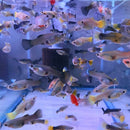Description
The Guppy, scientifically known as Poecilia reticulata, is one of the most popular and widely kept freshwater fish in the aquarium hobby. Known for their vibrant colors, ease of care, and lively behavior, guppies are a favorite among both beginner and experienced aquarists. Here’s a detailed description of this fascinating species:
Appearance
Color and Pattern: Guppies are renowned for their dazzling array of colors and patterns. Males are particularly vibrant, exhibiting a spectrum of colors including red, blue, green, yellow, and orange. Their bodies and fins can feature spots, stripes, and intricate patterns. Females, while generally less colorful, can still display a variety of hues and subtle patterns.
Body Shape: Guppies have a streamlined, slender body that is well-adapted for quick, agile swimming. Males are typically smaller and more slender than females.
Fins: Male guppies are especially prized for their large, flowing fins. The caudal fin (tail fin) can be fan-shaped, spade-shaped, or even lyre-shaped, and is often the most colorful part of the fish. The dorsal fin is also elongated and often displays vibrant colors. Females have shorter fins that are usually less flamboyant.
Size
Adult Size: Male guppies typically grow to about 1.5 inches (3.8 cm) in length, while females are larger, reaching up to 2.5 inches (6.4 cm).
Habitat and Tank Requirements
Tank Size: Guppies are relatively small and can thrive in smaller tanks. A minimum of 10 gallons is recommended, but larger tanks are preferred for more stable water conditions and to accommodate their active nature.
Water Conditions: Guppies prefer freshwater with a temperature range of 72-82°F (22-28°C) and a pH range of 6.8-7.8. They are adaptable but thrive best in stable, clean water conditions.
Substrate and Decorations: A fine gravel or sand substrate works well. Guppies enjoy a well-planted tank with both live and artificial plants, which provide hiding spots and enhance their vibrant colors. Smooth rocks, driftwood, and other decorations can be added to create a visually appealing environment.
Diet
Feeding: Guppies are omnivorous and have a varied diet. High-quality flake or pellet food designed for tropical fish should form the basis of their diet. Supplementing with live or frozen foods such as brine shrimp, daphnia, and bloodworms, as well as plant-based foods like spirulina flakes or blanched vegetables, helps ensure balanced nutrition.
Behavior and Compatibility
Temperament: Guppies are known for their peaceful and social nature. They are active swimmers and often exhibit playful behavior, especially males displaying to females or other males.
Social Needs: Guppies do best in groups and should be kept in schools of at least six individuals. They can coexist peacefully with other small, non-aggressive fish species, making them ideal for community tanks. However, males can sometimes be a bit nippy or competitive, especially during mating displays.
Lifespan
With proper care, guppies typically live for 2-3 years, though some can live longer in optimal conditions.
Breeding
Ease of Breeding: Guppies are livebearers and are known for their prolific breeding. Females give birth to live, free-swimming fry approximately every 30 days if males are present. It is common for guppies to breed in home aquariums without special intervention.
Fry Care: Fry can be raised in the main tank if there are plenty of hiding spots, but they are often moved to a separate breeding tank to ensure their survival. They should be fed finely crushed flake food or specialized fry food.
Payment & Security
Your payment information is processed securely. We do not store credit card details nor have access to your credit card information.


